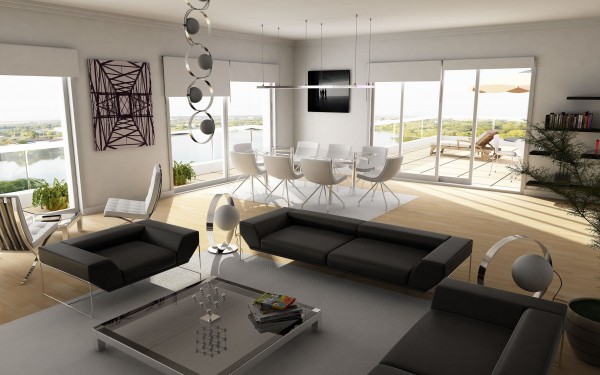Interior design professionals often rely on a wide range of software to perform their job. Some programs are designed for drawing/3D modeling only, others include project management, organization and sourcing functionality.
Roll up your sleeves. Passionate doodles on a paper towel from the cafe won’t cut it here; they must be converted to orderly, fixed plans that everyone from vendors to builders can follow.
Computer-Aided Design (CAD) Software
CAD software allows professionals to translate their design visions into realistic 3D visualization. They can then share these renderings with clients, which helps them better understand and envision their renovated space. This is a valuable tool that helps designers save time by automating repetitive tasks. It also helps them create and edit 2D drawings, including room layouts and floor plans.
The best CAD programs for interior designers can offer features like adjustable furniture, paint color, flooring and lighting options for photorealistic renderings of their designs. They may even include compatible virtual reality headsets for a more immersive experience. These programs can also integrate with other software and file formats.
Choosing the right program for your needs will depend on several factors, such as system requirements, the ability to use 2D or 3D sketches and how user-friendly the interface is for professional users. Designers should also consider whether the software offers a seamless integration with existing project management, photography and other software that they often use. Some programs may also be more affordable than others.
3D Modeling Software
While CAD software is the foundation of interior design, 3D modeling software allows for more intricate and detailed representations. This can help clients get a better idea of what the final product will look like and avoid any surprises during construction.
These programs often allow users to create multiple design options for a room instantly, swapping in and out furniture, fixtures, paint colors, and other components to see how different elements would look in a space. This gives clients more input in the design process and allows them to sign off on renderings before any physical work is done, which can save time and money.
Some programs include a library of furniture, decorations, and other objects to use in renderings, while others may require importing custom models. There are also a variety of programs available for various operating systems, such as macOS, Windows, and Android. One of the best 3D modeling software options for interior designers is Foyr Neo, which offers a zero learning curve, a robust library of objects and furnishings, and fast cloud-rendering.
Mood Board Software
Mood boards are the perfect tool for conveying your design concept to clients. While some designers may still use a poster board or piece of paper with photos and clip-outs, more technology-forward interior design professionals have begun to use digital mood board software.
When choosing a mood board creator, look for one that offers a variety of templates to suit your style and projects. Ideally, you’ll also find a tool that can sync with your product library and 3D floor plans so that products can be applied to those deliverables with the click of a button.
Beloved by stylists and decor hobbyists alike, Morpholio Board is a top choice for creating interior design mood boards. Its avant-garde cropping tool ensures every visual element fits perfectly into your narrative. Additionally, it allows users to create spreadsheets, organize ideas in folders and build multiple boards all from one platform. With a simple drag-and-drop interface, this software makes it easy to create beautiful and effective digital mood boards. It also supports video clips, links and text to truly bring your vision to life.
Project Management Software
Project management software can make a huge difference in the efficiency of an interior design team. Tasks like scheduling, tracking budgets and coordinating with contractors and clients can all be streamlined through this type of software. It allows designers to focus on their creative processes and deliver their services in a timely manner.
There are a number of dedicated interior design project management software tools, but many also offer these features in conjunction with other tools and functions. For example, Gather offers a digital resource library that helps designers store and organize items like item specifications and vendor contacts for complex projects. This information can be shared easily with clients and other collaborators.
Another tool that simplifies project management is Dropbox, a cloud storage and file-sharing platform. Its user-friendly interface allows for seamless collaboration with employees, contractors and clients, making it a popular choice among interior design professionals. In addition, it has a number of time-saving tools such as a project checklist that helps keep track of due dates and a Gantt chart that helps visualize deadlines.
Scheduling Software
Interior design software programs vary in scope and cost. Many programs offer complimentary trial periods that can help designers experiment with the program to find out if it works for them. Designers should also consider whether or not they might ever want to hire someone to work with them and, if so, what kind of interior design software they will need to be trained in.
Some online interior design programs, like Roomsketcher, allow users to create 2D and 3D renderings to share with clients. These programs also give clients a virtual walkthrough of their future space and allow them to alter the design with simple drag-and-drop tools.
Other programs, like Gather, are designed to be used by larger teams and can include features such as a client portal and a digital resourceful library for storing project specifications and vendor contact information. Gather also includes a built-in chat feature that centralizes communication and can be used to instantly get approvals from clients and contractors. The Solo plan starts at $65/month (billed annually) and supports one user, ten client accounts, and 50 projects.


